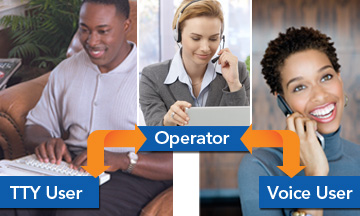TTY
People who are Deaf, hard of hearing, or have difficulty speaking can use a TTY (also known as a text telephone) to make and receive calls through Maryland Relay. A TTY has a keyboard, which allows the user to type his/her side of the conversation, and a text screen to read the other person’s responses.
How it Works

- The TTY user types his/her side of the conversation on the TTY's keyboard.
- A Maryland Relay Operator voices the TTY user's text to the other person.
- As the other person speaks in response, the Operator types the spoken words, which the TTY user reads on his/her TTY text screen.
Except for their role in relaying the call, Operators do not participate in conversations for any reason. Furthermore, all conversations are kept confidential by law.
Note: Relay services are regulated by the Federal Communications Commission (FCC). Users wishing to file a complaint regarding a Relay calling experience may do so using the FCC's online complaint form.
To Make a TTY Call
- Dial 7-1-1 or 800-735-2258 to initiate a TTY call through Maryland Relay.
- The Maryland Relay Operator’s typed greeting, including the Operator’s identification number, will display on your TTY or VCO phone.
- When the Operator is finished typing, you will see the letters “GA.” This means “Go Ahead.” Click here to see a list of commonly used TTY abbreviations.
- Type the number of the person you want to call, along with any special calling instructions. Then type “GA.”
- The Operator will type to you that the phone is "DIALING", "RINGING", OR "BUSY."
- When the other person answers, the Operator types the greeting spoken by that person, and then types (m) if the person is male or (f) if the person is female.
- Wait until you see “GA” before typing your response. Do not forget to type “GA” when you are finished with your response.
- When the conversation is over, type "GA to SK", or "SK SK" to hang up. “SK” stands for “Stop Keying.”
- If you would like to make another call, do not hang up. The Operator will remain on the line, ready to assist you, the moment your conversation ends.
TTY-to-TTY direct calling is available, and does not require the service of a Relay Operator. To learn more about making and receiving TTY calls, download detailed instructions now or call 800-552-7724 or 410-767-6960 (Voice/TTY) or 443-453-5970 (Video Phone) to request TTY user training.
Apply for a TTY Provided by the State
TTYs and other assistive telephone devices are available through the Maryland Accessible Telecommunications (MAT) program for qualified Maryland residents. Learn more about the MAT program.
